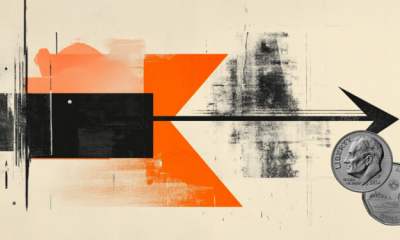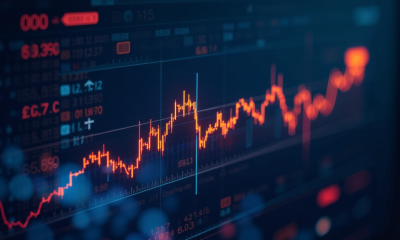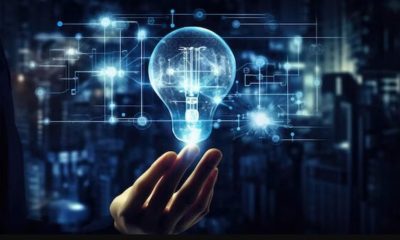

Metaverse
Art made by artificial intelligence is developing a style of its own – Crypto News
“Generative” AI models make convincing mimics, whether they are producing vintage portraits or more modern images—like a purported photo of the pope in an improbable Balenciaga puffer jacket, which recently tricked half of Twitter. Yet their ability to produce original work is less clear. “AI art has so far been exceptionally trivial,” a columnist in the Art Newspaper recently huffed. It is intrinsically derivative, based on the millions of training images that are consumed, digested and regurgitated to order. “Plagiarism is a feature of the AI process,” declared the Writers Guild of America, one of many creative-workers’ unions that sees generative AI models as mere copycats.
Perhaps so. Yet there are signs that AI models are developing an artistic style of their own—and not just in drawing hands with more than five digits, as was common in their early output. By identifying and accentuating the patterns they see in their training data, generative models are not so much mirrors of contemporary styles as they are magnifying lenses. Slowly, a robotic school of artwork is emerging.
Computers have been making art for some time. Five years ago Christie’s auctioned its first work created by artificial intelligence, “Edmond de Belamy”, a blurry approximation of an 18th-century oil painting. Despite being unfinished and faintly alien-looking, the novelty fetched $432,500. “It may not have been painted by a man in a powdered wig,” Christie’s said, “but it is exactly the kind of artwork we have been selling for 250 years.”
Technology has since come far. Open platforms such as Midjourney and Dall-E generate images in seconds based on simple written prompts. No artistic skill is required, though there is a knack to getting good results. “The image I produce isn’t my work. My work is the prompt,” says Nick St Pierre, a designer in New York who got into AI last year when he saw it coming for his job. The image above, which he made using Midjourney, took hundreds of iterations, ending up with this prompt:
35mm, 1990s action film still, close-up of a bearded man browsing for bottles inside a liquor store. WATCH OUT BEHIND YOU!!! (background action occurs)…a white benz truck crashes through a store window, exploding into the background…broken glass flies everywhere, flaming debris sparkles light the neon night, 90s cgi, gritty realism
The ability to order any image in any style, from action movies of the 1990s to papal paparazzi shots, seems incompatible with the idea of a distinctive AI look. Yet certain traits seem to predominate. One is nostalgia. The ability of AI models to recreate the styles they have been fed makes them adept at simulating the look of old media, or sometimes recreating past events in modern guise. One recent viral series imagined modern-day selfies taken in pre-modern times, with Vikings or cavemen grinning for the camera.
As in previous eras of art, the prevailing subject matter is determined by whoever commissions the work. Western galleries groan with pictures of rich white men and their property, not because they looked good in oil paint but because these were the themes dearest to the hearts of patrons. Midjourney’s output is big on anime warrior princesses for the same reason.
AI models seem to favour particular techniques, too. Examining images produced by Midjourney earlier this year, Roland Meyer, a researcher at Ruhr University Bochum in Germany, noticed a common look. Many would “shine and sparkle, as if illuminated from within”. They combined this distinctive lighting with a colour palette that contrasted warm earthy tones with blue or green metallic ones. Many also displayed what photographers call “high dynamic range”, meaning a wide variation in light levels within the image, with pools of deep shadow and other areas brightly lit.
These traits are not coincidental. Mr Meyer attributes the distinctive “glow” to the way AI models handle lighting. Rather than using digital art techniques such as ray tracing, in which a computer calculates how light will fall on an object from a particular angle, AI imagines how things will look based on the images in its training data, which have been illuminated from many different angles. For this reason, even photo-realistic AI images seem to be lit in a way more akin to painting than to naturalistic photography, Mr Meyer says.
Painting by numbers
The favoured colour schemes, meanwhile, often pair teal or turquoise with orange or magenta. That reflects a taste popularised on Instagram and from there across the internet, which is likely to have been well-represented in training data. (High dynamic range has been made similarly ubiquitous online by modern smartphone cameras, which produce such effects by taking several images at different exposures and stitching them together.)
With updates to AI models come changes to their oeuvre. David Holz, the founder and boss of Midjourney, rejects the idea that there is a single AI style. The latest version of the program, released in March, has reined in some of the tendencies of the previous one, he says. “The look of our images has radically changed five times now over the past 12 months and will continue to do so for quite some time,” Mr Holtz insists. “People want diversity.”
As the models evolve and improve, they will remain reliant on man-made training data. “No collection is ever neutral,” says James Coupe, head of photography at the Royal College of Art in London, where he is setting up an AI lab. “Image archives are indexes of a society’s changing ideological investments and political commitments.” And whatever the training data, “we are going to end up with a style that is a kind of lowest common denominator of art.” He compares AI-generated images to a project in the 1990s by a pair of Russian conceptual artists, Vitaly Komar and Alexander Melamid. They surveyed public tastes in 14 countries and produced artworks based on the results. Nearly everyone went for banal 19th-century-style landscapes.
By identifying and condensing prevailing styles in their training data, generative-AI models are playing a similar role. Mr Meyer thinks their ability to summarise visual styles or eras could make them powerful tools of analysis for art historians. Both their weakness and their strength is that, as he puts it, they are “cliché detectors”.
© 2023, The Economist Newspaper Limited. All rights reserved.
From The Economist, published under licence. The original content can be found on www.economist.com
-

 Technology2 days ago
Technology2 days agoChatGPT users are mass cancelling OpenAI subscriptions after GPT-5 launch: Here’s why – Crypto News
-

 Technology1 week ago
Technology1 week agoMeet Matt Deitke: 24-year-old AI whiz lured by Mark Zuckerberg with whopping $250 million offer – Crypto News
-
Technology6 days ago
Binance to List Fireverse (FIR)- What You Need to Know Before August 6 – Crypto News
-
others1 week ago
XRP NIGHT Token Airdrop: Snapshot, Claim Date and What to Expect? – Crypto News
-

 Cryptocurrency1 week ago
Cryptocurrency1 week agoXRP inflows drop 95% since July spike, while Chaikin data signals possible rally – Crypto News
-

 Blockchain1 week ago
Blockchain1 week agoBank of America Sees Interest in Tokenization of Real-World Assets – Crypto News
-

 Blockchain1 week ago
Blockchain1 week agoAltcoin Rally To Commence When These 2 Signals Activate – Details – Crypto News
-
others1 week ago
Breaking: Strategy Files $4.2 Billion STRC Offering To Buy More Bitcoin – Crypto News
-
Business1 week ago
Breaking: Solana ETFs Near Launch as Issuers Update S-1s With Fund Fees – Crypto News
-
Business1 week ago
Bitpanda Co-Founder & Co-CEO Paul Klanschek Steps Down as Firm Eyes Frankfurt IPO – Crypto News
-
Cryptocurrency1 week ago
Cardano’s NIGHT Airdrop to Hit 2.2M XRP Wallets — Find Out How Much You Can Get – Crypto News
-
Technology1 week ago
Beyond Billboards: Why Crypto’s Future Depends on Smarter Sports Sponsorships – Crypto News
-

 Technology1 week ago
Technology1 week agoOppo K13 Turbo series confirmed to launch in India with in-built fan technology: Price, specs and everything expected – Crypto News
-

 De-fi1 week ago
De-fi1 week agoWhite House Crypto Report Recommends Expanding CFTC’s Role in Crypto Regulation – Crypto News
-
Technology1 week ago
Coinbase to Offer Tokenized Stocks and Prediction Markets in U.S. – Crypto News
-

 others1 week ago
others1 week agoCanadian Dollar under pressure amid weak GDP, Trump tariff threat, and strong US data – Crypto News
-

 De-fi1 week ago
De-fi1 week agoCourt Overturns Fraud Conviction of OpenSea’s Nate Chastain – Crypto News
-

 Cryptocurrency1 week ago
Cryptocurrency1 week agoStablecoins Are Finally Legal—Now Comes the Hard Part – Crypto News
-

 Technology7 days ago
Technology7 days agoGoogle DeepMind CEO Demis Hassabis explains why AI could replace doctors but not nurses – Crypto News
-
![WBC Elliott Wave analysis and Elliott Wave forecast [Video]](https://dripp.zone/news/wp-content/uploads/2025/01/WBC-Elliott-Wave-analysis-and-Elliott-Wave-forecast-Video-400x240.jpg)
![WBC Elliott Wave analysis and Elliott Wave forecast [Video]](https://dripp.zone/news/wp-content/uploads/2025/01/WBC-Elliott-Wave-analysis-and-Elliott-Wave-forecast-Video-80x80.jpg) others1 week ago
others1 week agoCan the record-breaking rally last? – Crypto News
-

 Technology1 week ago
Technology1 week agoSolana DEX volume dips 20% after co-founder slams meme coins – Crypto News
-

 Technology1 week ago
Technology1 week agoTim Cook confirms Apple will ramp up AI spending, ‘open’ to acquisitions – Crypto News
-

 Technology1 week ago
Technology1 week agoBig Tech’s Big Bet on AI Driving $344 Billion in Spend This Year – Crypto News
-
Cryptocurrency1 week ago
CME XRP Futures Hit Record Highs in July Amid ETF Approval Optimism – Crypto News
-

 Cryptocurrency1 week ago
Cryptocurrency1 week agoTron Eyes 40% Surge as Whales Pile In – Crypto News
-

 Cryptocurrency1 week ago
Cryptocurrency1 week agoEthereum Hits Major 2025 Year Peak Despite Price Dropping to $3,500 – Crypto News
-

 Blockchain1 week ago
Blockchain1 week agoXRP Must Hold $2.65 Support Or Risk Major Breakdown – Analyst – Crypto News
-

 Blockchain1 week ago
Blockchain1 week agoXRP Must Hold $2.65 Support Or Risk Major Breakdown – Analyst – Crypto News
-

 Technology7 days ago
Technology7 days agoBest computer set under ₹20000 for daily work and study needs: Top 6 affordable picks students and beginners – Crypto News
-
Business6 days ago
Analyst Spots Death Cross on XRP Price as Exchange Inflows Surge – Is A Crash Ahead ? – Crypto News
-

 Technology5 days ago
Technology5 days agoOppo K13 Turbo, K13 Turbo Pro to launch in India on 11 August: Expected price, specs and more – Crypto News
-

 De-fi5 days ago
De-fi5 days agoTON Sinks 7.6% Despite Verb’s $558M Bid to Build First Public Toncoin Treasury Firm – Crypto News
-
Blockchain5 days ago
Shiba Inu Team Member Reveals ‘Primary Challenge’ And ‘Top Priority’ Amid Market Uncertainty – Crypto News
-

 others5 days ago
others5 days agoBank of America CEO Denies Alleged Debanking Trend, Says Regulators Need To Provide More Clarity To Avoid ‘Second-Guessing’ – Crypto News
-

 Technology5 days ago
Technology5 days agoOpenAI releases new reasoning-focused open-weight AI models optimised for laptops – Crypto News
-

 Technology1 week ago
Technology1 week agoOppo K13 Turbo series confirmed to launch in India with in-built fan technology: Price, specs and everything expected – Crypto News
-

 Blockchain1 week ago
Blockchain1 week agoBitcoin Price Pressures Remain as US Nonfarm Payrolls Miss the Mark – Crypto News
-

 Blockchain1 week ago
Blockchain1 week agoBitcoin Price Pressures Remain as US Nonfarm Payrolls Miss the Mark – Crypto News
-

 Blockchain1 week ago
Blockchain1 week agoStrategy Expands STRC Offering Twice in One Week – Crypto News
-
others1 week ago
Major Ripple Partner Reveals Bold Plans for RLUSD, ETFs And Global Payments – Crypto News
-
Technology1 week ago
Will The First Spot XRP ETF Launch This Month? SEC Provides Update On Grayscale’s Fund – Crypto News
-

 Technology1 week ago
Technology1 week agoAmazon Great Freedom Sale deals on smartwatches: Up to 70% off on Samsung, Apple and more – Crypto News
-
Business1 week ago
Is Quantum Computing A Threat for Bitcoin- Elon Musk Asks Grok – Crypto News
-

 Technology1 week ago
Technology1 week agoElon Musk reveals why AI won’t replace consultants anytime soon—and it’s not what you think – Crypto News
-
others7 days ago
Japan CFTC JPY NC Net Positions down to ¥89.2K from previous ¥106.6K – Crypto News
-

 Cryptocurrency6 days ago
Cryptocurrency6 days agoLido Slashes 15% of Staff, Cites Operational Cost Concerns – Crypto News
-
others5 days ago
MetaPlanet Launches Online Clothing Store As Part of ‘Brand Strategy’ – Crypto News
-

 Blockchain5 days ago
Blockchain5 days agoCrypto Market Might Be Undervalued Amid SEC’s New Stance – Crypto News
-

 Technology5 days ago
Technology5 days agoiPhone users alert! Truecaller to discontinue call recording feature for iOS from September 30. Here’s what you can do… – Crypto News
-

 Technology5 days ago
Technology5 days agoiPhone users alert! Truecaller to discontinue call recording feature for iOS from September 30. Here’s what you can do… – Crypto News












